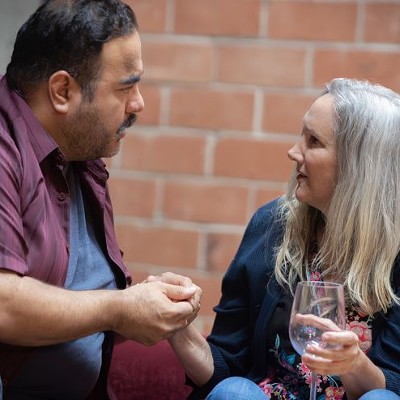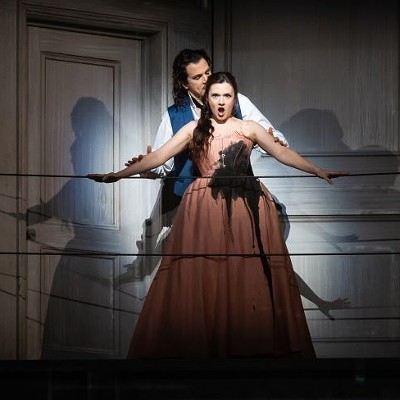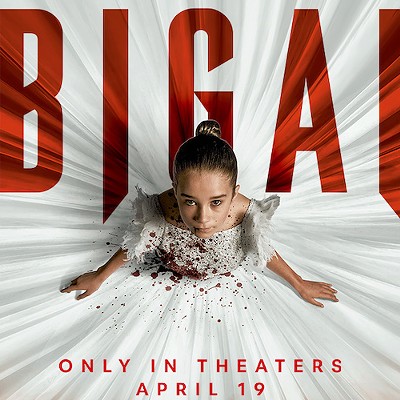When it comes to art, it’s easy to get lost in terminology, especially art that’s new to you. I know because I did that as I tried to understand “As Essential as Dreams: Self-Taught Art from the Collection of Stephanie and John Smither,” an exhibition that opened recently at the Menil Collection, curated by Michelle White. What made this art self-taught as opposed to folk or visionary or vernacular or other terms I’d heard?
But pretty quickly I realized that naming it is a lot less important than just looking at it. Looking at Amazons Hunting Bear Style (that’s the title in the catalog; the painting actually says Accupunture Bear Style), by Uncle Jack Dey, for instance, with its tribe of naked, spear-wielding women chasing a sleuth of bleeding bears — crudely painted, with brash colors and a bold misspelling.
What, I wondered, are we supposed to make of that? If it were by Picasso or Andy Warhol, who will both have exhibitions at the Menil later this year, at least we’d have some idea where to start, thanks to all those years of going to exhibitions and reading catalogs. But not even the catalog helps with Amazons. We may have the exhilarating (or frightening) feeling of being flung out on our own — like one of the Amazons or fleeing bears, depending on our personal art-courage quotient.
And what about Johnnie Swearingen’s Cotton Picking, painted in 1991? It’s clearly a memory scene. The wagons are pulled by mules and the cotton is picked by field hands pulling sacks that look like huge white slugs snaking through the rows. Swearingen would have known this scene from his Chappell Hill childhood, probably would have picked himself. I remember my mother describing how she did it as a girl. But by 1991, mechanization had made it a memory.
One of the refreshing things about an exhibition like this is the permission it gives a major museum to show work by artists who are not the usual A-list few. You know what I mean. As it is with actors in British TV dramas, so it is, all too often, with artists in museums — it sometimes seems that there are only 20 in the world, and so we see the same ones everywhere — New York or London, Tokyo or Houston, doesn’t matter. They’re great; we love them; their names are always a draw. But really, only 20? Surely there must be more than that worth looking at. (I understate for effect, of course; there are actually 21.)
Unless you’re a self-taught specialist, “As Essential as Dreams” is almost guaranteed to show you work by people you’ve never seen before. Even specialists may be surprised by a few. It’s a new field of collecting, and the net is being cast wide. But we mustn’t dawdle. The canon is already being formed — that list of those who are generally considered “worth” looking at — even in this relatively new, non-canonical field.
In preparation for this review, I borrowed a stack of books on the subject, and found that some of the same names (Thornton Dial, Bill Taylor, Howard Finster) appeared in many of them. They’re in this show too, along with others. It’s sort of like going to Cuba before it gets messed up by all the tourists. Oops, already too late. Collectors Stephanie and John Smither, however, made it to this particular Cuba early, with a passion for the field that grew over the decades the more work they saw and the more artists they got to know. They were willing to take risks on the new and the unknown; and, since they weren’t collecting hundred million dollar Picassos, they could afford to.
Not that images like these are completely new to the world. As I walked through the exhibition I saw pieces that reminded me of things I’d seen before. Domenico Zindato put me in mind of Paul Klee; Howard Finster, with his angels shooting past Casper-the-Ghost clouds, of Pre-Renaissance Italian primitives; an untitled John B. Murray watercolor made me think of the Frenchman Jean Dubuffet — not surprising, perhaps, since it was Dubuffet’s own collection of art brut that gave the first big push to the self-taught collecting movement back in the mid-20th Century. You can see some of Dubuffet’s own work, drawing on elements he found in art brut, down the hall in the Menil modernist galleries.
I’m not suggesting that these self-taught artists likely looked at the very-taught names I’ve linked them to. Maybe yes, maybe no. Nobody knows but them. But the art impulse isn’t necessarily different, whether taught or not. Go next door and look at “William N. Copley: The World According to CPLY.” I surprised myself by liking it when the show opened back in February. CPLY’s milieu from childhood on was moneyed, educated, and insider, but there’s a lot of the same look going on in the two shows, even though the sources may be different. Or maybe not so different, since the source is always some ultimately unknowable place inside each artist. The categories, outsider/insider, self-taught/other-taught, begin to fall apart.
I was struck as I toured “As Essential as Dreams” by how recent much of the work is, some from only a year or two ago. I counted maybe three pieces that were older than me, and though I’m old I’m not that old. Mostly this is a collection of newish art — what you’d have to call contemporary, even though much of it looks “old-timey.”
And much of it is distinctly local. Self-taught, outsider, whatever you call them, artists can be from particular places that are not New York or Los Angeles, and it’s not a damning pejorative to say so. Southern, even Texan, aren’t dirty words when referring to them, not even in museums. Regional, provincial, local is OK. Try saying that about taught, insider, whatever you want to call them, artists and see the glares you get. A double standard, you wonder? You might well think so; I could not possibly comment.
If you’re a minimalist, you might not like living with these objects — at least not the way the Smithers did, which is salon style to the max, floor-to-ceiling-wall-to-wall, according to a photo in the catalog. Even being in the Menil galleries, where the hanging is pretty much the same — very un-museum-like in the contemporary aesthetic — might be enough to make a curator or an au courant exhibition goer queasy. Being pretty passé myself, I like it.
For me, “As Essential as Dreams” is part garden of earthly delights (yes, that’s a reference to Hieronymus Bosch); part vision of paradise or hell seen through eyes on the fringes; part plunge into crazy-land. It’s full of beautiful, disturbing, sometimes unforgettable images that may be untutored but still have a good deal to teach.
“As Essential as Dreams: Self-Taught Art from the Collection of Stephanie and John Smither”
Through October 16, The Menil Collection, 1515 Sul Ross, 713-525-9400, menil.org
After this review was written, we received the sad news that collector and philanthropist Stephanie Smither died on June 11, just a day after the opening of this exhibition of the collection she and her husband, John Smither, formed together.
Support Us
Houston's independent source of
local news and culture
account
- Welcome,
Insider - Login
- My Account
- My Newsletters
- Contribute
- Contact Us
- Sign out
The “As Essential as Dreams” Collection Is Almost Guaranteed to Surprise
Randy Tibbits June 21, 2016 8:00AM
[
{
"name": "Related Stories / Support Us Combo",
"component": "11591218",
"insertPoint": "4",
"requiredCountToDisplay": "4"
},{
"name": "Air - Billboard - Inline Content",
"component": "11591214",
"insertPoint": "2/3",
"requiredCountToDisplay": "7"
},{
"name": "R1 - Beta - Mobile Only",
"component": "12287027",
"insertPoint": "8",
"requiredCountToDisplay": "8"
},{
"name": "Air - MediumRectangle - Inline Content - Mobile Display Size 2",
"component": "11591215",
"insertPoint": "12",
"requiredCountToDisplay": "12"
},{
"name": "Air - MediumRectangle - Inline Content - Mobile Display Size 2",
"component": "11591215",
"insertPoint": "4th",
"startingPoint": "16",
"requiredCountToDisplay": "12"
}
,{
"name": "RevContent - In Article",
"component": "12527128",
"insertPoint": "3/5",
"requiredCountToDisplay": "5"
}
]
KEEP THE HOUSTON PRESS FREE...
Since we started the Houston Press, it has been defined as the free, independent voice of Houston, and we'd like to keep it that way. With local media under siege, it's more important than ever for us to rally support behind funding our local journalism. You can help by participating in our "I Support" program, allowing us to keep offering readers access to our incisive coverage of local news, food and culture with no paywalls.
Randy Tibbits is an independent art writer and curator, specializing in the art history of Houston. He is a member of the Board of Directors of CASETA: Center for the Advancement and Study of Early Texas Art and the coordinator of HETAG: Houston Earlier Texas Art Group. He writes art exhibition reviews for Houston Press from time to time.
Trending Arts & Culture
- Fallout Successfully Makes the Transition From Video Game to Streaming Show
- Love is in the Alley's Charming Production of Brontë Classic Jane Eyre
- The 10 Best And Most Controversial Hustler Magazine Covers Ever (NSFW)
-
Sponsored Content From: [%sponsoredBy%]
[%title%]

Don't Miss Out
SIGN UP for the latest
arts & culture
news, free stuff and more!
Become a member to support the independent voice of Houston
and help keep the future of the Houston Press FREE
Use of this website constitutes acceptance of our
terms of use,
our cookies policy, and our
privacy policy
The Houston Press may earn a portion of sales from products & services purchased through links on our site from our
affiliate partners.
©2024
Houston Press, LP. All rights reserved.





